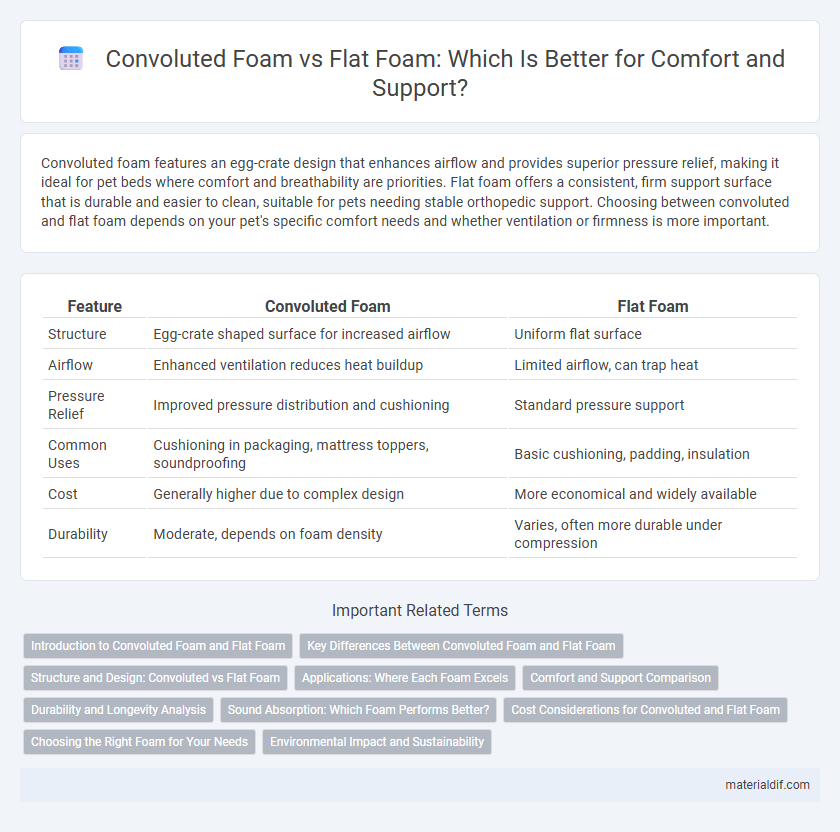Convoluted foam features an egg-crate design that enhances airflow and provides superior pressure relief, making it ideal for pet beds where comfort and breathability are priorities. Flat foam offers a consistent, firm support surface that is durable and easier to clean, suitable for pets needing stable orthopedic support. Choosing between convoluted and flat foam depends on your pet's specific comfort needs and whether ventilation or firmness is more important.
Table of Comparison
| Feature | Convoluted Foam | Flat Foam |
|---|---|---|
| Structure | Egg-crate shaped surface for increased airflow | Uniform flat surface |
| Airflow | Enhanced ventilation reduces heat buildup | Limited airflow, can trap heat |
| Pressure Relief | Improved pressure distribution and cushioning | Standard pressure support |
| Common Uses | Cushioning in packaging, mattress toppers, soundproofing | Basic cushioning, padding, insulation |
| Cost | Generally higher due to complex design | More economical and widely available |
| Durability | Moderate, depends on foam density | Varies, often more durable under compression |
Introduction to Convoluted Foam and Flat Foam
Convoluted foam features an egg-crate pattern that enhances airflow and provides targeted cushioning, making it ideal for mattress toppers and soundproofing applications. Flat foam, on the other hand, offers uniform density and thickness, delivering consistent support and durability often used in furniture padding and packaging. Both types of foam serve specific roles based on their structural design and performance characteristics, catering to diverse comfort and protection needs.
Key Differences Between Convoluted Foam and Flat Foam
Convoluted foam features an egg-crate or wedge-shaped surface that enhances airflow and provides pressure relief by contouring to the body, making it ideal for cushioning and soundproofing. Flat foam offers a uniform, smooth surface that delivers consistent support and durability, commonly used in upholstery, mattresses, and insulation applications. The key difference lies in their structure and functionality, where convoluted foam improves ventilation and comfort, while flat foam emphasizes stable support and straightforward fabrication.
Structure and Design: Convoluted vs Flat Foam
Convoluted foam features an egg-crate pattern designed to enhance airflow and provide targeted pressure relief by distributing weight evenly. Flat foam offers a uniform, smooth surface ideal for consistent support without contouring, making it suitable for basic cushioning needs. The structural difference between convoluted and flat foam significantly impacts comfort, breathability, and application versatility.
Applications: Where Each Foam Excels
Convoluted foam excels in applications requiring enhanced airflow and cushioning, such as mattress toppers, soundproofing panels, and packaging for delicate items, due to its egg-crate structure that promotes ventilation and pressure distribution. Flat foam is preferred in applications demanding uniform support and aesthetic consistency, commonly used in upholstery, automotive seating, and custom-cut cushion inserts where a smooth, even surface is essential. Each foam type maximizes performance by fitting specific needs: convoluted foam for breathability and impact absorption, and flat foam for structural stability and precise shaping.
Comfort and Support Comparison
Convoluted foam features a distinctive egg-crate design that enhances airflow and provides targeted pressure relief, making it ideal for comfort-sensitive applications like mattress toppers and cushions. Flat foam offers consistent density across the surface, delivering even support but less breathability and contouring compared to convoluted foam. Users seeking balanced comfort and support often prefer convoluted foam for its combination of softness and adaptive cushioning, while flat foam suits those prioritizing firm, uniform support.
Durability and Longevity Analysis
Convoluted foam offers enhanced breathability and pressure distribution but typically wears down faster due to its increased surface exposure compared to flat foam. Flat foam boasts greater durability and longevity, maintaining structural integrity longer under consistent compression and daily use. Choosing between convoluted and flat foam depends on the balance between comfort needs and the desired lifespan of the foam product.
Sound Absorption: Which Foam Performs Better?
Convoluted foam offers superior sound absorption compared to flat foam due to its uneven surface that increases the surface area and traps sound waves more effectively. The peaks and valleys in convoluted foam diffuse sound energy, reducing echo and noise more efficiently in acoustic treatments. Flat foam, while effective for basic cushioning, lacks the textured design that enhances sound absorption performance in environments requiring noise control.
Cost Considerations for Convoluted and Flat Foam
Convoluted foam typically incurs higher production costs due to its intricate egg-crate-like design, which requires specialized cutting and molding processes. Flat foam presents a more cost-effective option, benefiting from simpler manufacturing techniques and lower material waste. Budget-conscious applications often prefer flat foam without sacrificing essential cushioning performance.
Choosing the Right Foam for Your Needs
Convoluted foam offers enhanced airflow and pressure relief, making it ideal for mattress toppers and cushions where breathability and comfort are priorities. Flat foam provides consistent support and durability, suitable for applications requiring firm cushioning such as furniture padding or soundproofing panels. Selecting the right foam depends on factors like intended use, comfort preference, and necessary support levels to optimize functionality and longevity.
Environmental Impact and Sustainability
Convoluted foam, often made from polyurethane, typically has higher waste levels during production due to its intricate shape compared to flat foam sheets, which are easier to manufacture with less material loss. Flat foam is more commonly recyclable and can be repurposed efficiently, contributing to a lower environmental footprint. Choosing flat foam promotes sustainability by reducing waste and enabling better end-of-life recycling options.
Convoluted foam vs Flat foam Infographic

 materialdif.com
materialdif.com